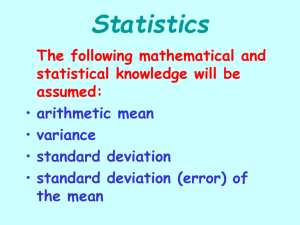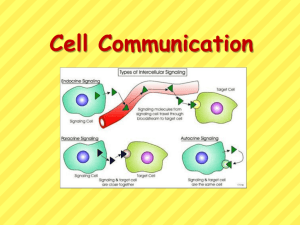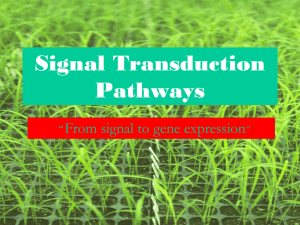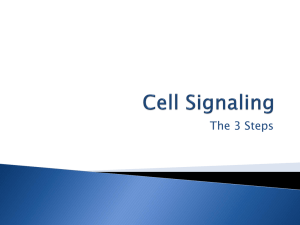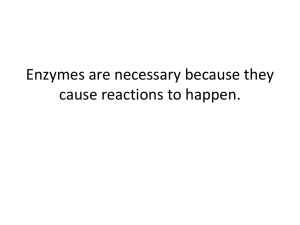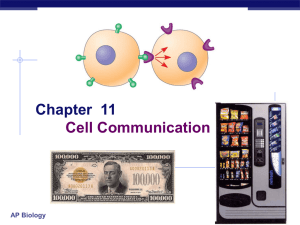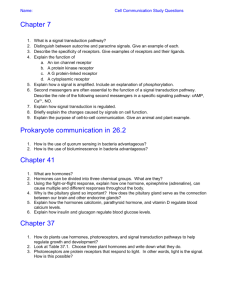Communication ppt - Gull Lake Community Schools
advertisement
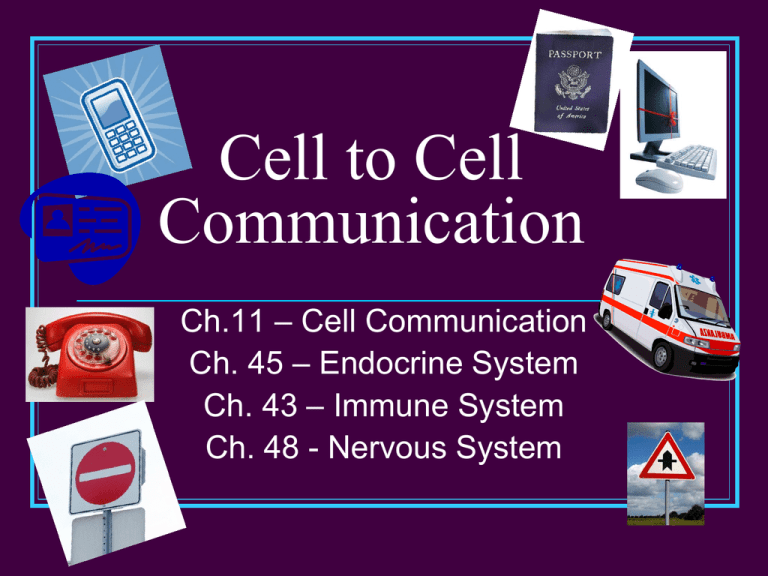
Cell to Cell Communication Ch.11 – Cell Communication Ch. 45 – Endocrine System Ch. 43 – Immune System Ch. 48 - Nervous System Goals: “I can …” Understand why cells communicate in multicellular organisms Aknowledge that even unicellular bacteria “share information” Understand the methods cells use to communicate Give specific examples of cell communication related to various systems of the body (endocrine, nervous and immune) Communication Cells must be able to move materials (Na+, H2O, O2) across space (cytoplasm) and membranes (within, in/out and between cells) Cells must be able to move information (DNA &RNA) across space (cytoplasm) and membranes (within, in/out and between cells) Cells must be able to move messages (enzymes, hormones, neurotransmitters, antigens, etc) across space (cytoplasm and synapses) and membranes (within, in/out and between cells) MANDATORY in multicelluar organisms Forms of Communication Communication between cells can be Physical Chemical (enzymes, hormones, antigens, antibodies and fertilization) Signal / reaction Concentration Recognition Electrical (nerve impulses) Touch Light Polarization Most change permeability of a membrane Review of Proteins PROTEIN FUNCTION Contractile; actin, myosin Cytoskeleton fibers and filaments that contract and thus pull on CM; change shape and/or move cell Messenger; adenaline Cause changes in permeability that allow nerve to fire Regulatory/hormonal; insulin Regulate whether or not a reaction is on/off or a compound is being made Structural; collagen Used to build and/or anchor Storage; albumin, casein Supply amino acids to an infant plant or animal Defense; antigen, antibody Recognize self and defend against abnormal and nonself Reactions; lytic enzyme Catalyze a chemical reaction Transport; hemoglobin Bind to and then transport substances throughout the body Carrier; membrane pumps Move substances across CM as needed Review of Plasma Membrane; pg 128 Membrane Transport Proteins; pg 129 and 135 Integral (transmembrane) proteins Channel proteins Channel or tunnel through which molecules can pass, passive Carrier proteins Alternates between 2 shapes and moving solutes, passive Ion pumps Active transport, shape change, Enzymatic Signal transduction Cell to cell recognition Review of Junctions Tight junction: cells are tight together and bound by proteins – keep skin waterproof Gap junction: cytoplasmic channels between cells, membrane proteins surround a pore – molecules can pass Desmosomes: function like rivets, keratin proteins Plasmodesmata / Plants – channels in cell walls that allow cytosol to move from cell to cell. Water and small molecules are continuous. Fig. 11-4 Plasma membranes Gap junctions Animal Cells: between animal cells Gap Junctions (a) Cell junctions Plasmodesmata Plant cells: between plant cells Plasmodesmata Cell to Cell Recognition (b) Cell-cell recognition 11.1 Signal Transduction Pathways Process by which a signal on a cell’s surface is converted to a specific cellular response through a series of steps Reception Transduction Response Long distance vs Local Local Influence cells in the vicinity Growth factors Synaptic signaling Many cells can respond Long distance Signals are released by specialized cells and travel through the system, only being recognized by target cells – hormones and pheromones Electrical portion of nerve impulses Specificity 3 steps in signaling Reception – target cell’s detection of a signal molecule coming from outside and binding to receptor protein on the cells surface Transduction – bonding changes receptor protein in some way, initiating transduction, start of pathway – may be protein construction or enzymatic reaction Response - triggering of a specific cellular response, Right time, right place, right amount, right sequence, right conditions, etc Fig. 11-7b G Protein Coupled Receptors pg 211 Plasma membrane G protein-coupled receptor Activated receptor Signaling molecule GDP CYTOPLASM GDP Enzyme G protein (inactive) GTP 2 1 Activated enzyme GTP GDP Pi Cellular response 3 4 Inactive enzyme Fig. 11-7c Receptor Tyrosine Kinases pg 212 Ligand-binding site Signaling molecule (ligand) Signaling molecule Helix Tyrosines Tyr Tyr Tyr Tyr Tyr Tyr Tyr Tyr Tyr Tyr Tyr Tyr Tyr Tyr Tyr Tyr Tyr Tyr Receptor tyrosine kinase proteins CYTOPLASM Dimer 1 2 Activated relay proteins Tyr Tyr Tyr Tyr Tyr Tyr P Tyr P Tyr 6 ATP Activated tyrosine kinase regions 6 ADP P Tyr Tyr P Tyr P Tyr P P Tyr Tyr P P Tyr P Tyr Tyr P P Tyr Fully activated receptor tyrosine kinase Inactive relay proteins 3 4 Cellular response 1 Cellular response 2 Fig. 11-7d 1 Signaling molecule (ligand) Gate closed Ions Ion Channel Receptors Pg 213 Ligand-gated ion channel receptor Plasma membrane 2 Gate open Cellular response 3 Gate closed 11.2 Reception Ligand – molecule that has specific binding affinity to another molecule. Causes a shape change – directly activates receptor to interact with another molecule Receptors in Plasma membrane G Protein Coupled Receptors Tyrosine receptor kinases Ion channel receptors Intracellular Receptors - hydrophobic or small to pass through CM (steroids, thyroid hormones and NO) Only target cells have correct receptors In cytoplasm In nucleus – transcription factors; control which genes are “on” 11.3 Transduction Pathways: chain of molecular events, usually involve removal of PO4, signal molecule usually never enters cell Cascades: series of molecules in pathway are phosphorylated in turn, “fan out” Phosphorylation / dephosphorylation: Protein kinase is enzyme that transfers P from ATP to a protein. 2% of genes code for kinases ! Protein phosphatases are enzymes that remove P – inactivating protein Second messengers: small, nonprotein, water soluble molecules or ions, spread rapidly by diffusion, cyclic AMP and Ca+2 Cyclic AMP and Calcium 11.4 Response Regulation of one or more cell activities Regulation of protein synthesis ( genes on/off) Regulation of activity of a protein Open or shut a gate or channel In cytoplasm and/or nucleus Liver cell and cardiac muscle cells both respond to epinephrine – liver breaks down glycogen and heart beats more rapidly…. Different kinds of cells have different collections of proteins. Programmed cell death: Apoptosis Endocrine system Communication examples from endocrine system Nervous system Communication examples from nervous system Immune system Communication examples from immune system Learner Outcomes Read a scientific article and relate ideas to concept of cell communication. See links between chemistry and membrane structure Have a basic understanding of the immune, endocrine and nervous systems. Practice Essay Questions Previous AP Exam question (2010) 1. Homeostatic maintenance of optimal blood glucose levels had been intensively studied in vertebrate organisms. A. Pancreatic hormones regulate blood glucose levels. Identify TWO pancreatic hormones and describe the effect of each hormone on blood glucose levels. B. For ONE of the hormones you identified in A.) identify ONE target cell and discuss the mechanism by which the hormone can alter activity in the target. Include in your discussion a description of cellular reception, transduction and response. Compare the cell-signaling mechanisms of steroid hormones and protein hormones Pg. 227 in Campbell and Reece 8th ed. Scientific Inquiry # 11 Science Technology and Society # 12
